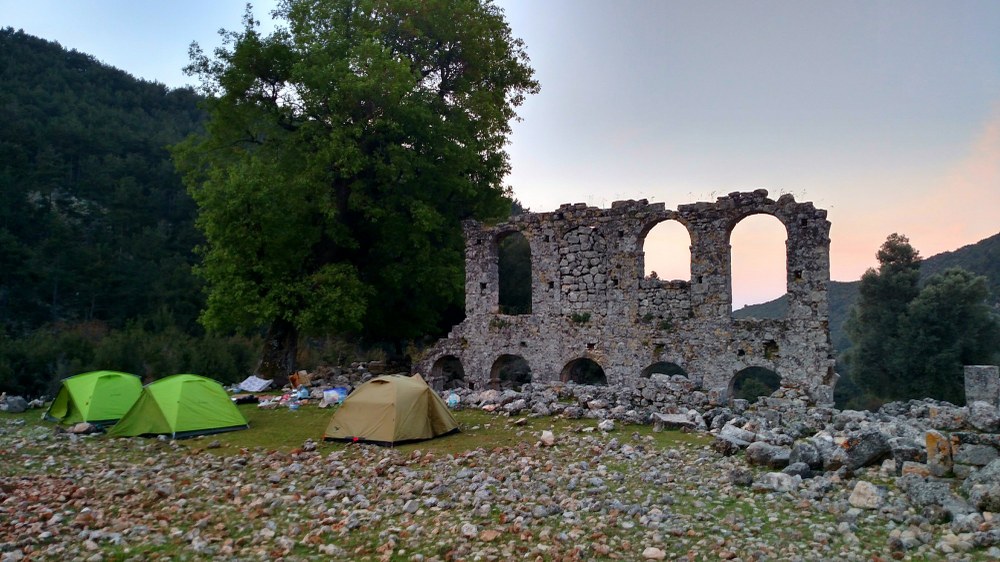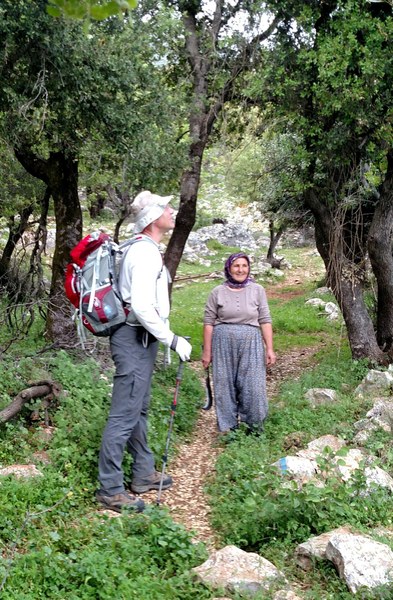
Chunks of rough rock covered our trail in the dry, scrubby foothills of the Taurus Mountains. The Mediterranean Sea glittered below us as we climbed, 85 miles into our 115-mile, 14-day journey.
Our Mountaineers group was walking the Lycian Way, a 500-kilometer coastal trail in southwestern Turkey that snakes through ancient Lycia. Built from old footpaths and mule trails, this trail offers a glimpse into the Bronze Age against the backdrop of a stunning coastline. That day we climbed past toppled Lycian sarcophagi and tumbled ruins of ancient stone wrapped in elegant red strawberry trees, a local variety of madrone.
As we crested the hilltop, maneuvering around boulders and clumps of vivid euphorbia, a compound of plastic-draped shacks emerged from the fog. Two big, cream-colored dogs rose and shook. The pealing of bells and the child-like screams of goats reached us through the murk.
Suddenly, tumbling through the trees, the goats arrived – black, white, spotted, horned and bearded, elderly and babies, pushing and shoving for a prime spot on the narrow path to look at us. As we walked forward they jostled to follow. If we turned to look at them they stopped short, their beady goat-eyes staring and beards quivering. Few creatures do curiosity better than a goat.

Yoruk goat herder in the hills of Lycia. Photo by Cheryl Talbert.
Bustling down the hill behind the goats was a compact and vigorous-looking woman in a headscarf, her long sleeves pushed up her arms and blousy pants gathered at the ankle in the local village style. Her face was creased with a cautious smile and she carried a large, curved machete (our Turkish guide later learned that it was for cutting branches to feed the youngest goats).
She was Yörük, a member of the nomadic herder population thought to be among the oldest-surviving inhabitants of the Taurus Mountains, and the last example of a traditional way of life that once dominated Anatolian culture. Since the eleventh century, the Yörük have made the long summer trek into the Taurus Mountains to pasture their goats, sheep, and horses, returning to their coastal villages before the autumn snows. Though some remain nomadic, the vast majority now live and work in local towns, visiting their ancestral highlands for a picnic or family holiday.
The pride and richness of the nomadic tribes of southern Anatolia was on full display at a festival that came upon us unexpectedly in Demre the day before. We had spent the morning taking in stunning frescoes in the 5th century Church of St. Nicholas, Lycian cave tombs from the 12th century BC, and a first-century AD Roman amphitheater. Suddenly a bustle of music and color burst onto the sidewalk alongside our cafe. Several local tribes had gathered to connect and celebrate their distinctive music, crafts, and heritage. Each had their own brightly-colored traditional dress, musical instruments, beribboned donkeys and camels, and big smiles.
The next day’s trekking route took us into a remote rocky valley where we camped under an arched wall from the sixth-century Alakalise church. Up the valley from the ruin, a pair of Yörük women set up a temporary compound, including a pen made of sticks and wire. As night fell the women and dogs brought in their herd of at least 50 goats and kids from the surrounding rocky pasture. A cacophony of frenzied bleating ricocheted between the valley walls. The women quickly milked the nanny goats, gently pushing away the young ones. As they finished, the animals quieted and peace settled over the valley. By early the next morning, the women, dogs, and goats had vanished into the day’s pastures, and we began our own descent through the rocky hills that held a culture – both modern and ancient – in its arms.
Interested in your own international experience? Though we’ve had to postpone our 2020 adventures, watch for more Global Adventures trips in 2021 and beyond, led by our experienced volunteers. For more information, visit mountaineers.org/globaladventures.
This article originally appeared in our Fall 2020 issue of Mountaineer Magazine. To view the original article in magazine form and read more stories from our publication, visit our magazine archive.
 Cheryl Talbert
Cheryl Talbert